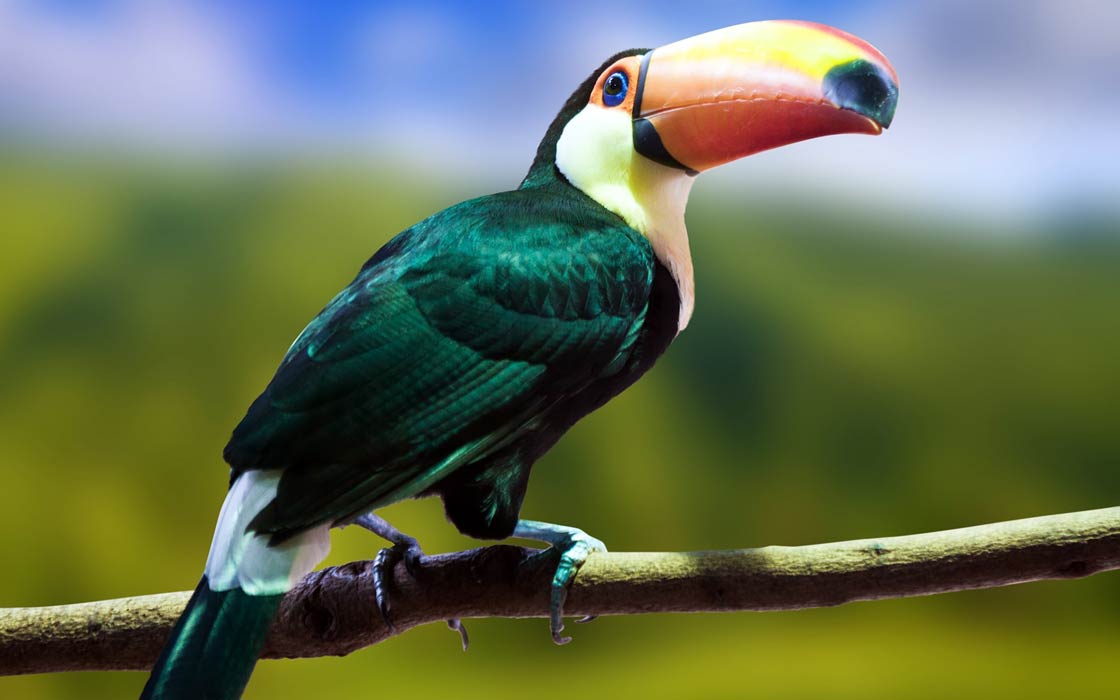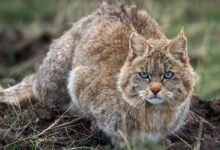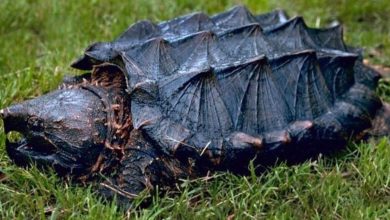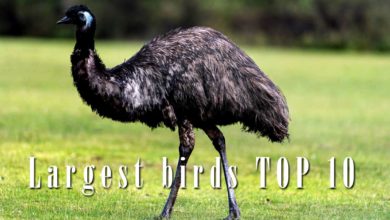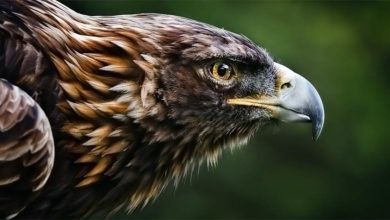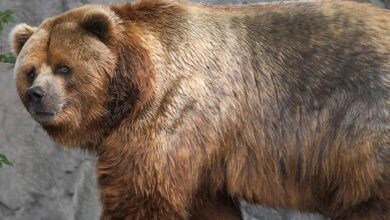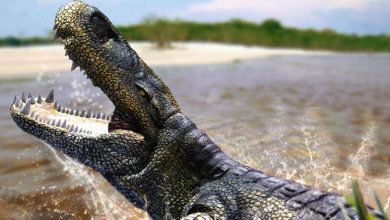Toucans – Guardians of the Rainforest
Toucans are a wonder of nature, with their distinctive beaks and colorful plumage, they are an icon of the rainforest. These birds are not only visually striking but also hold a fascinating place in history and culture, from ancient civilizations to modern-day conservation efforts. Whether you’re an avid birdwatcher or simply intrigued by the natural world, the toucan is a creature worth discovering. So, let’s dive into the world of toucans and uncover the remarkable facts and stories that make them one of the most marvelous and interesting creatures on our planet.
Toucans are a group of birds known for their distinctive, oversized beaks and colorful plumage. These birds are found in the rainforests of Central and South America, where they play an important role in the ecosystem as seed dispersers and predators of insects and small vertebrates.
Toucans are known for their unique beaks, which can be up to a third of the bird’s total length. Although their beaks may appear heavy and cumbersome, they are actually made of lightweight, bony material covered in a thin layer of keratin, similar to human fingernails. This makes them strong yet lightweight, allowing the birds to use them for a variety of tasks such as reaching for fruit and insects, preening their feathers, and even defending themselves against predators.
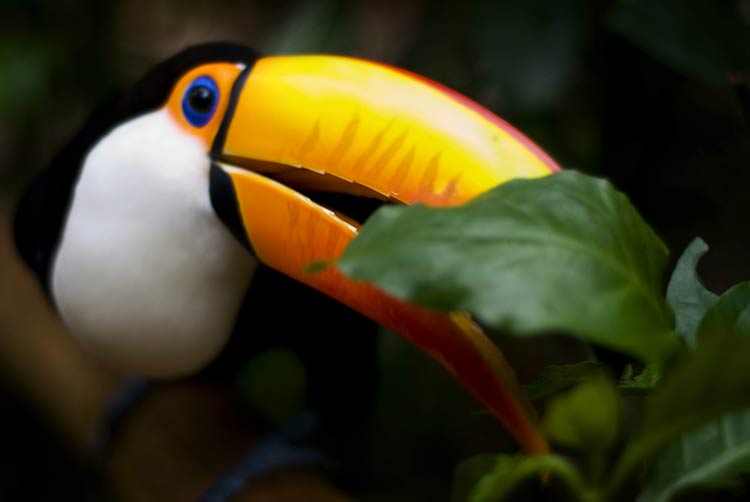
Toucans and Their Ecological Role in Central and South America
These birds are also notable for their bright, colorful plumage, which can range from shades of black, white, and gray to vivid hues of red, orange, and blue. Their feathers are used for display during courtship rituals and also serve as camouflage to help them blend in with their forest surroundings.
Toucans are generally social birds that live in small flocks or pairs. They communicate with each other through a variety of vocalizations, including loud, raucous calls that can be heard over long distances.
Overall, toucans are fascinating and unique creatures that are not only visually stunning but also play an important role in maintaining the health and diversity of the rainforest ecosystem.

Taxonomy
Toucans belong to the family Ramphastidae, which is a family of near-passerine birds that includes approximately 46 species. The family Ramphastidae is part of the order Piciformes, which also includes woodpeckers, barbets, and honeyguides.
Scientific classification
- Kingdom: Animalia
- Phylum: Chordata
- Class: Aves
- Order: Piciformes
- Infraorder: Ramphastides
- Family: Ramphastidae
Within the family Ramphastidae, toucans are divided into five genera:
- Aulacorhynchus
- Andigena
- Selenidera
- Pteroglossus
- Ramphastos
Each of these genera contains several species of toucans, which are distinguished from each other by variations in their beak size and coloration, as well as other physical and behavioral characteristics.
The scientific name for the common toco toucan is Ramphastos toco, while the lettered aracari’s scientific name is Pteroglossus inscriptus. These scientific names are derived from Latin and are used worldwide to standardize the naming of species in taxonomy.

Basic Facts About Toucans
- Toucans are a group of near-passerine birds found in Central and South America.
- They are known for their large, colorful beaks, which can be up to one-third of their total body length.
- There are about 46 species of toucans, divided into five genera: Aulacorhynchus, Andigena, Selenidera, Pteroglossus, and Ramphastos.
- Toucans primarily feed on fruit, but they also eat insects, small lizards, and eggs.
- They are social birds and often live in small flocks or pairs.
- Toucans are cavity nesters and typically lay two to four eggs in a hollow tree or other cavity.
- Their brightly colored feathers are used for display during courtship rituals and can also serve as camouflage.
- Toucans have a distinctive vocalization that sounds like a croaking or yelping noise.
- They play an important role in the ecosystem as seed dispersers and predators of insects and small vertebrates.
- Toucans have a lifespan of up to 20 years in captivity.
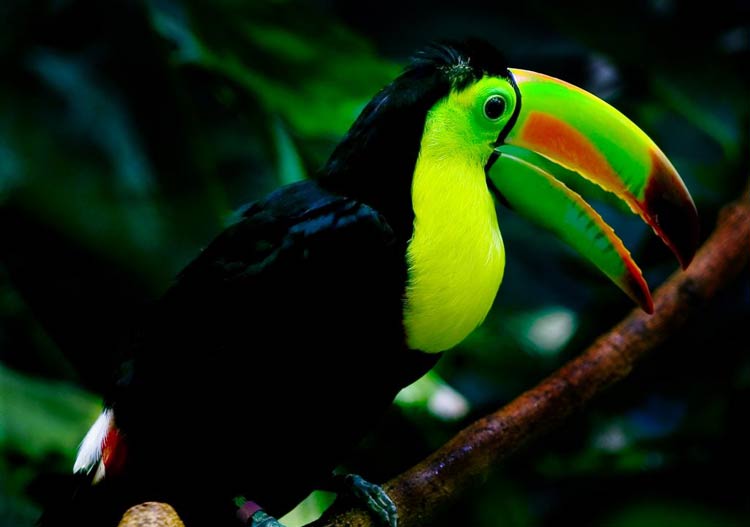
Distribution and habitat
Toucans are found in the tropical forests of Central and South America, from southern Mexico to northern Argentina. They are most diverse in the Amazon basin, but can also be found in other forested regions, including the Atlantic Forest, the Chocó-Darién, and the Andean cloud forests.
Toucans are arboreal birds, meaning they primarily live and feed in trees. They can be found in a variety of forest types, including lowland rainforests, montane cloud forests, and even some drier forests. They are also known to inhabit disturbed areas such as forest edges, secondary growth forests, and fruit orchards. However, they are not typically found in open savannas or grasslands.
Toucans require large trees with cavities for nesting, and are often associated with old-growth forest habitats. They are also dependent on fruit trees for food and are known to travel long distances in search of ripe fruit. In addition, they require access to sources of water, such as streams or pools, for drinking and bathing. Overall, toucans are highly adaptable birds and can survive in a variety of forested habitats.
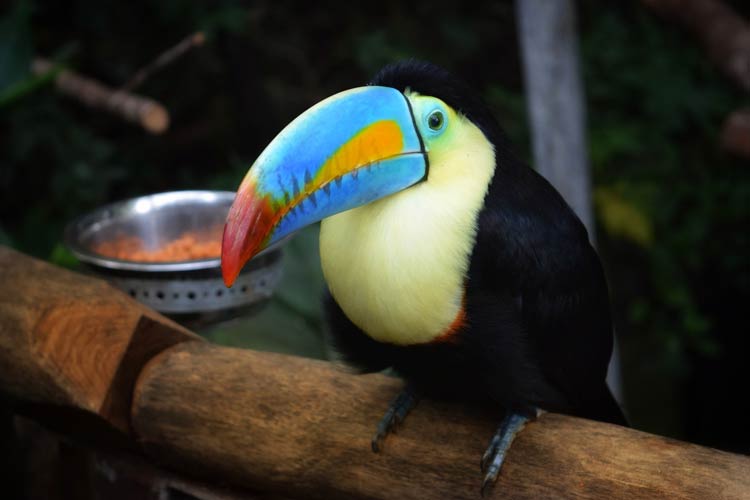
Characteristics
Appearance
Toucans are known for their distinctive and colorful appearance, which includes their large, brightly colored bills. Here are some additional details about their appearance:
- Toucans are generally medium-sized birds, ranging from about 30-60 centimeters (12-24 inches) in length and weighing between 100-600 grams (3.5-21 ounces), depending on the species.
- Their most notable physical characteristic is their large, brightly colored bill, which can be up to one-third of their total body length. The bill is made of a lightweight material called keratin, the same substance found in human hair and nails.
- The coloration of a toucan’s bill varies depending on the species, but can include bright hues of yellow, orange, green, and red.
- Toucans have short, rounded wings and a long, broad tail, which helps them maintain balance while perched in trees.
- Their plumage is generally black with patches of color on their neck, chest, and wings. The coloration varies between species but can include shades of green, blue, white, and red.
- Toucans have zygodactyl feet, meaning that two toes point forward and two point backward. This helps them grip branches and move around in trees.
- Males and females of most species have similar plumage and bill size, although males may be slightly larger in some cases.
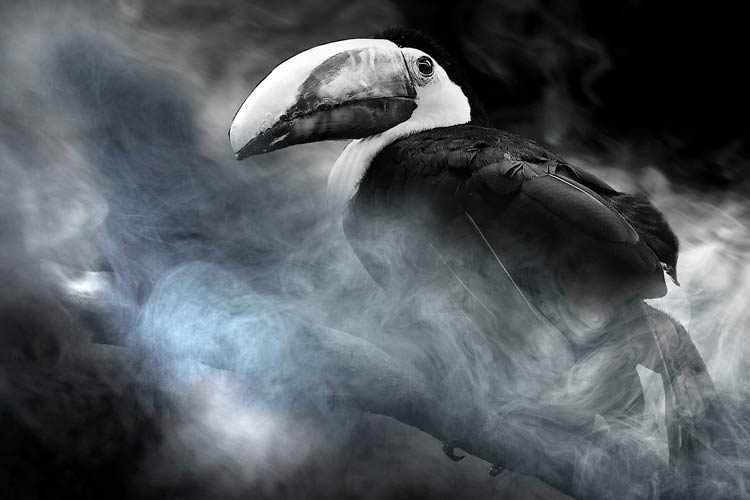
Size – the smallest and the largest toucans
The smallest toucan
The smallest toucan is the lettered aracari (Pteroglossus inscriptus), which is only about 33-35.5 centimeters (13-14 inches) long and weighs between 100-185 grams (3.5-6.5 ounces), depending on the subspecies.
The largest toucan
On the other hand, the largest toucan is the toco toucan (Ramphastos toco), which can reach a length of 55-63 centimeters (22-25 inches) and weigh between 500-876 grams (18-31 ounces), again depending on the individual.
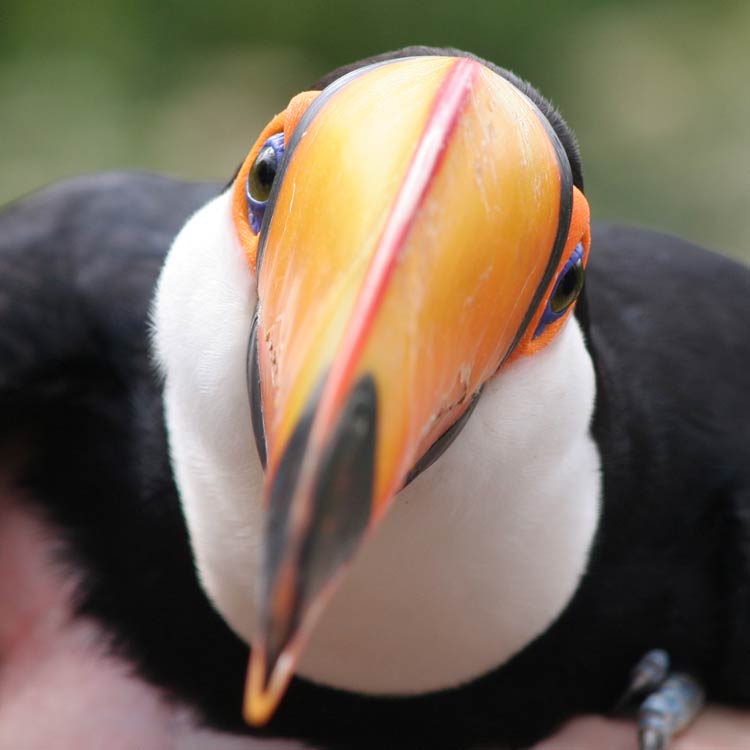
Why does the toucan have such a large beak?
The toucan’s large beak is not only visually striking, but also serves a variety of important functions. It is thought to help regulate the bird’s body temperature, attract mates, and access hard-to-reach foods in its rainforest habitat.
The beak also contains a network of blood vessels that may help dissipate excess body heat, making it a useful adaptation in the hot, humid environment where toucans live. Additionally, the bill may serve as a form of protection against predators, as its large size and bright colors may help to deter potential attackers.

Behavior, Lifestyle and ecology
Toucans are social birds that typically live in small flocks of up to six individuals, although larger groups have been observed in areas with abundant food resources. Here are some additional details about their behavior, lifestyle, and ecology:
- Toucans are diurnal, meaning they are active during the day and rest at night. They spend most of their time foraging for food and socializing with other toucans.
- Their diet consists primarily of fruit, but they also eat insects, lizards, and other small animals. They are important seed dispersers, as the undigested seeds in their feces are often deposited far from the parent tree, helping to establish new plants and promote forest diversity.
- Toucans are cavity nesters, meaning they rely on holes in trees or other structures to lay their eggs and raise their young. They do not excavate their own nest cavities but instead use abandoned woodpecker holes or natural hollows in trees.
- Toucans have a unique sleeping behavior, where they tuck their bills under their wings and hunch their bodies to reduce heat loss during the cool nights in the forest.
- They communicate with each other through a variety of calls, including croaks, clucks, and chatters. These vocalizations are used for socializing, alarm calls, and territorial defense.
- Toucans play an important ecological role in the forest ecosystem, as seed dispersers, predators, and prey for other animals. They are also popular with tourists and birdwatchers, contributing to the local economy in areas where they occur.
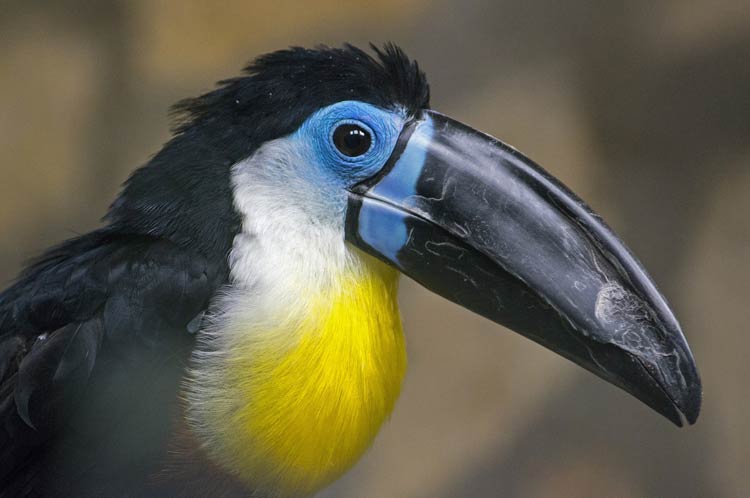
Diet
Toucans have a primarily frugivorous (fruit-eating) diet, but they also eat insects, small vertebrates, and eggs. In fact, research has shown that up to half of their diet may consist of insects, which they may catch by snatching them from the air or plucking them off of foliage.
Toucans have a unique feeding behavior where they toss their heads back and swallow fruit whole, aided by their large gape and flexible necks. This allows them to eat fruit that is too large for other birds of their size to consume.
Their frugivorous diet also makes them important seed dispersers, as they eat a wide variety of fruit and excrete the undigested seeds, which helps to establish new plants and promote forest diversity. In addition to their role as seed dispersers, toucans may also benefit the trees they feed on by pruning branches, removing infected fruit, and reducing the number of fruit-eating insects that might damage the plant.
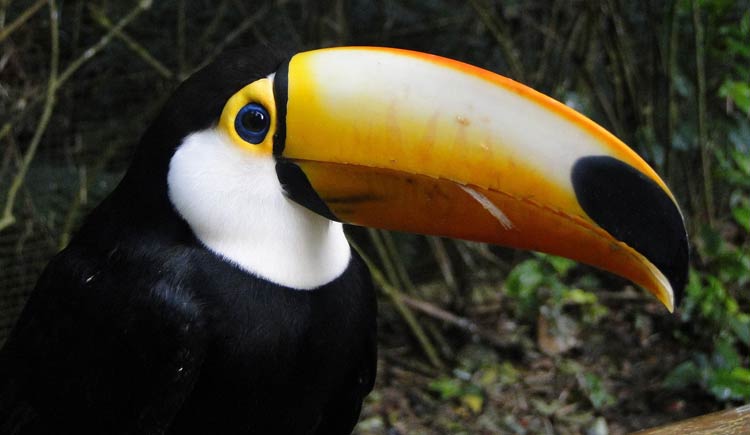
Reproduction and parenting
Toucans are monogamous and form long-term pair bonds. During the breeding season, which varies depending on the species and the region, toucans engage in courtship displays that involve bill-touching, hopping, and vocalizations.
The female toucan typically lays 2-4 eggs in a natural tree cavity or an abandoned woodpecker hole. Both parents take turns incubating the eggs for around 16-18 days until they hatch. The chicks are born blind, naked, and helpless and are completely dependent on their parents for food and care.
Both parents work together to feed the chicks, bringing them fruit, insects, and other small prey. The chicks grow rapidly, and their bills develop over time, starting as small nubs and eventually growing into their characteristic long and colorful beaks.
Once the chicks fledge and leave the nest, they may stay with their parents for a period of time, learning important skills such as foraging and social behaviors. Toucans may only produce one clutch of eggs per year, and the juveniles may not reach reproductive maturity until they are 3-4 years old.
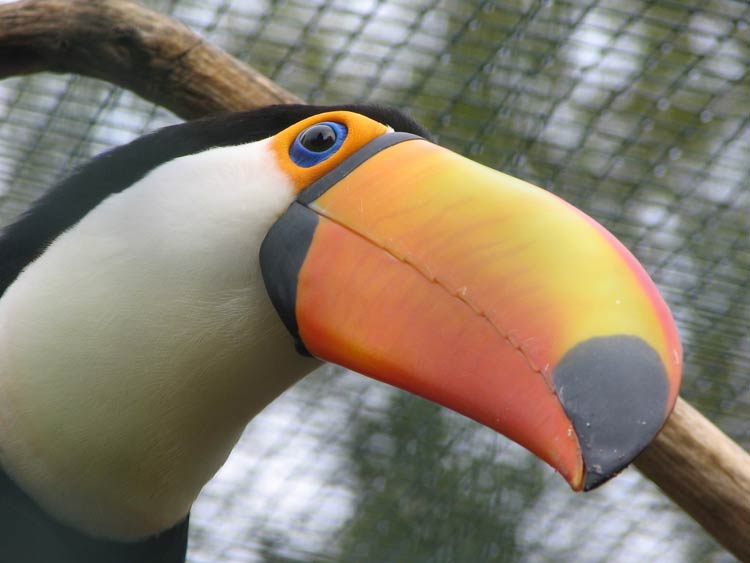
Predators and Threats
Toucans face a number of threats and predators in their habitats. Some of their natural predators include large raptors such as hawks and eagles, as well as snakes, opossums, and other arboreal predators.
However, toucans are also threatened by human activities, including deforestation and habitat loss due to agriculture, logging, and development. Hunting and poaching for their colorful beaks, which are often used in traditional medicine and for ornamental purposes, is also a major threat to toucan populations.
Climate change may also have an impact on toucans, as it can alter their habitats and food sources. In addition, changes in rainfall patterns and temperature could have indirect effects on the species by disrupting the reproductive cycles of the plants that toucans depend on for food.
Conservation efforts are being made to protect toucans and their habitats. These include establishing protected areas and reserves, promoting sustainable land-use practices, and working with local communities to reduce hunting and poaching pressures. Public education and awareness campaigns are also important in promoting conservation efforts and reducing demand for toucan products.
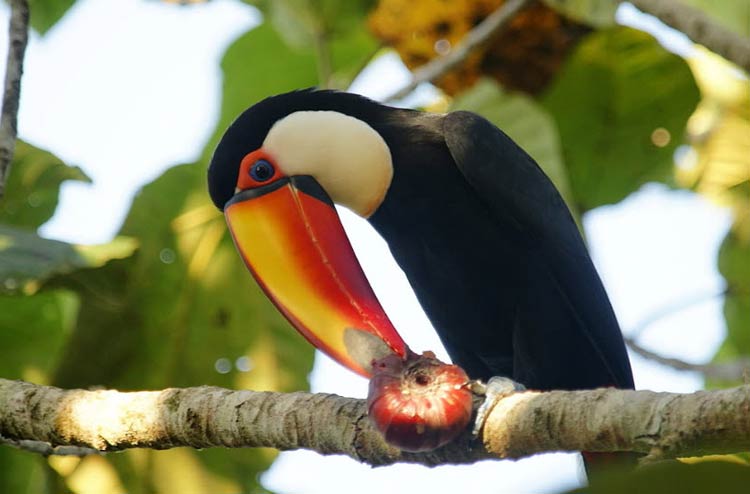
Interactions with humans
Toucans have a long history of interaction with humans, and have played important roles in many cultures throughout their range. In some areas, toucans are considered sacred or symbolic animals, and are featured in art, folklore, and religious ceremonies.
However, toucans have also been exploited by humans for their colorful beaks, which are often used for ornamental purposes or as souvenirs. In some cultures, the beaks are also used in traditional medicine. Hunting and poaching of toucans for their beaks is a major threat to their populations, and is illegal in many countries.
In addition to being hunted, toucans are also affected by human activities such as deforestation and habitat loss due to agriculture and development. Climate change may also have an impact on toucans and their habitats.
Conservation efforts are underway to protect toucans and their habitats, including the establishment of protected areas and reserves, promoting sustainable land-use practices, and working with local communities to reduce hunting and poaching pressures. Public education and awareness campaigns are also important in promoting conservation efforts and reducing demand for toucan products.
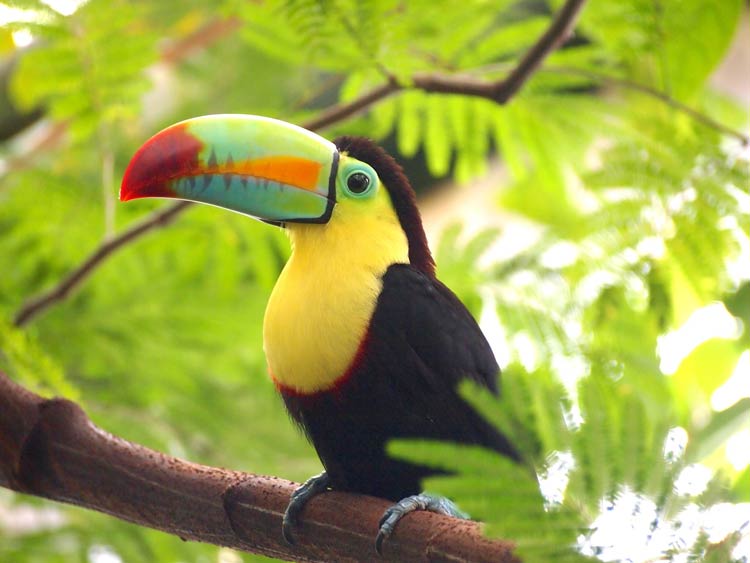
Population
Due to their wide range and varying habitats, population estimates for toucans are difficult to determine. However, many toucan species are considered to be of least concern by the International Union for Conservation of Nature (IUCN), indicating that their populations are relatively stable.
However, some species of toucans are threatened by habitat loss, hunting and poaching, and climate change. The Ramphastos vitellinus, for example, is listed as near threatened by the IUCN due to habitat loss and fragmentation, while the toco toucan (Ramphastos toco) is listed as a species of least concern, but with a decreasing population trend.
Conservation efforts are important in protecting toucan populations and their habitats from threats such as hunting, deforestation, and climate change. This includes the establishment of protected areas and reserves, promoting sustainable land-use practices, and working with local communities to reduce hunting and poaching pressures.
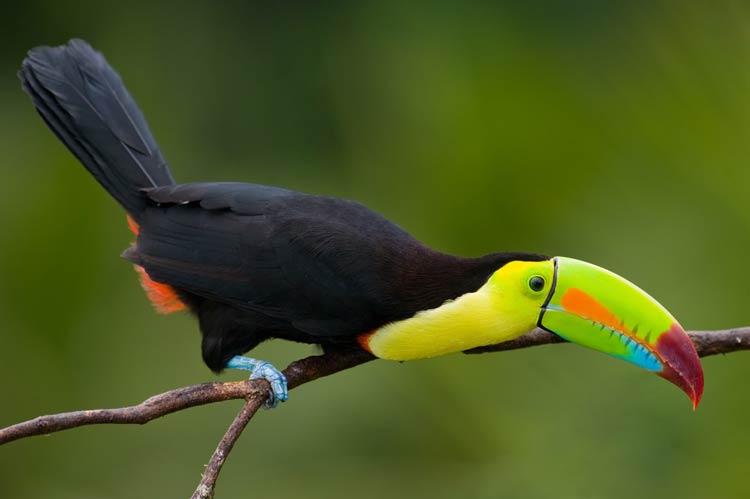
Status and conservation
As mentioned earlier, many species of toucans are considered to be of least concern by the International Union for Conservation of Nature (IUCN), indicating that their populations are relatively stable. However, some species of toucans are threatened by habitat loss, hunting and poaching, and climate change.
There are several species of toucans that are listed as vulnerable or near threatened by the IUCN, including the Channel-billed Toucan (Ramphastos vitellinus), the White-throated Toucan (Ramphastos tucanus), and the Chestnut-eared Aracari (Pteroglossus castanotis). The main threats to these species are habitat loss and fragmentation due to deforestation and human activities, as well as hunting and poaching for their colorful beaks.
Conservation efforts are important in protecting toucan populations and their habitats from threats such as hunting, deforestation, and climate change. This includes the establishment of protected areas and reserves, promoting sustainable land-use practices, and working with local communities to reduce hunting and poaching pressures. Public education and awareness campaigns are also important in promoting conservation efforts and reducing demand for toucan products.
By implementing these conservation measures, we can ensure that these fascinating and iconic birds continue to thrive in the wild for future generations to enjoy.

Toucans – fast facts
- Toucans range in size from the lettered aracari (Pteroglossus inscriptus) to the toco toucan (Ramphastos toco).
- The lettered aracari (Pteroglossus inscriptus) is 33 to 35.5 cm long (13-14 in), with a weight of about 100 to 185 g (3.5-6.5 ounces), depending on the subspecies.
- The toco toucan (Ramphastos toco) is the largest toucan, with a total length of 55-63 cm (22-25 inches) and a weight of 500-876 g (18-31 ounces), depending on sex.
- Toucans have large, colorful bills that can be up to one-third of their total body length.
- Toucan bills are made of a lightweight material called keratin, which is the same material that makes up human hair and nails.
- Toucans have zygodactyl feet, which means that two toes point forward and two toes point backward, giving them a better grip on branches.
- Toucans are primarily arboreal, spending most of their time in the treetops of tropical rainforests.
- Toucans are omnivores, feeding on a variety of fruits, insects, and small animals.
- Toucans are cavity nesters, using natural tree hollows or abandoned woodpecker holes to build their nests.
- Toucan eggs are white and are typically laid in clutches of two to four.
- Toucans are known for their distinctive vocalizations, which include a variety of croaks, yelps, and barks.

Detailed data / dimensions
Toucans (Ramphastidae)
- Length: 30 – 63 cm (11.8 – 24.8 in)
- Weight: 100 – 876g
- Beak length: up to 15 cm (5.9 in)
- Tongue length: up to 15 cm (5.9 in)
- Lifespan: up to 20 years
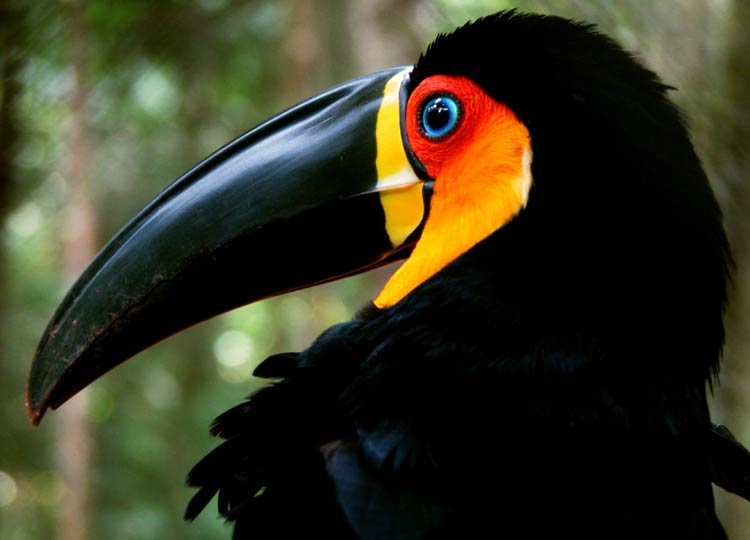
Toucans in culture
Toucans have a significant presence in popular culture, both in their native habitats and around the world. Here are some examples:
- Toucans are often featured in artwork, textiles, and jewelry made by indigenous peoples in the Amazon rainforest and other tropical regions of the Americas.
- Toucans are also popular mascots for sports teams, brands, and other organizations. For example, Toucan Sam is the cartoon mascot for Froot Loops cereal, and the toucan is the mascot for the Brazilian airline Gol Linhas Aéreas.
- Toucans have also appeared in numerous books, films, and other media. The children’s book “Toucan Toucan’t” by Juliette MacIver and Sarah Davis features a toucan who learns to embrace his unique talents, while the animated film “Rio” features a toucan named Rafael who befriends the main characters.
- Toucans have been depicted on postage stamps from several countries, including Brazil, Colombia, and Suriname.
- Toucans have also inspired numerous works of art and literature, including the poem “The Toucan” by Ogden Nash and the painting “The Bluebird of Happiness and the Toucan of Money” by Salvador Dali.
- Toucans are sometimes kept as pets, although this is illegal in many countries due to concerns about their conservation status and welfare in captivity.

Toucans in movies
Toucans have appeared in several movies and television shows over the years. Here are some examples:
- “Rio” (2011) is an animated film about a macaw named Blu who travels to Rio de Janeiro to mate with the last female of his species. Along the way, he befriends a toucan named Rafael, voiced by George Lopez.
- “Rio 2” (2014) is a sequel to “Rio” in which Blu and his family travel to the Amazon rainforest to search for other members of their species. Rafael and his family also appear in this film.
- “The Wild Thornberrys Movie” (2002) is an animated film about a family of nature documentary filmmakers. In the film, they encounter a group of toucans who help them find a missing cheetah.
- “The Lion King 1 1/2” (2004) is a direct-to-video animated film that retells the story of “The Lion King” from the perspective of Timon and Pumbaa. In one scene, they encounter a toucan who helps them find their way.
- “George of the Jungle” (1997) is a live-action film based on the cartoon of the same name. In the film, George befriends a toucan named Tookie, voiced by John Cleese.
These are just a few examples of toucans in movies. Toucans have also appeared in numerous documentaries and nature films, showcasing their unique appearance, behavior, and habitat.

Interesting Facts about Toucans
- Toucans have a unique adaptation that allows them to balance their large bill. They have lightweight, honeycomb-like bone structure that helps them avoid muscle strain.
- Despite their large size, toucans have small tongues that are often described as “brush-like” or “fringed.”
- Toucans are known for their distinctive calls, which can be heard up to half a mile away. They use these calls to communicate with other toucans and establish territory.
- Toucans have a unique diet that includes fruit, insects, and even small lizards and bird eggs. They play an important role in seed dispersal and pollination in their habitats.
- In some indigenous cultures of South America, toucans are considered a symbol of fertility and good luck.
- Toucans are often found in pairs or small groups, and they are known to be social birds. They communicate with each other using body language and calls.
- Some species of toucans, such as the toco toucan, have bright colors on their bills. Scientists believe that these colors may help them attract mates.
- Toucans are cavity nesters, meaning they lay their eggs in tree hollows or other enclosed spaces. Both the male and female help incubate the eggs and raise the young.
- Toucans have a relatively long lifespan for birds, with some species living up to 20 years in the wild.
- Toucans are often kept as pets, but they require specialized care and a large amount of space to thrive. In some countries, it is illegal to keep toucans as pets.
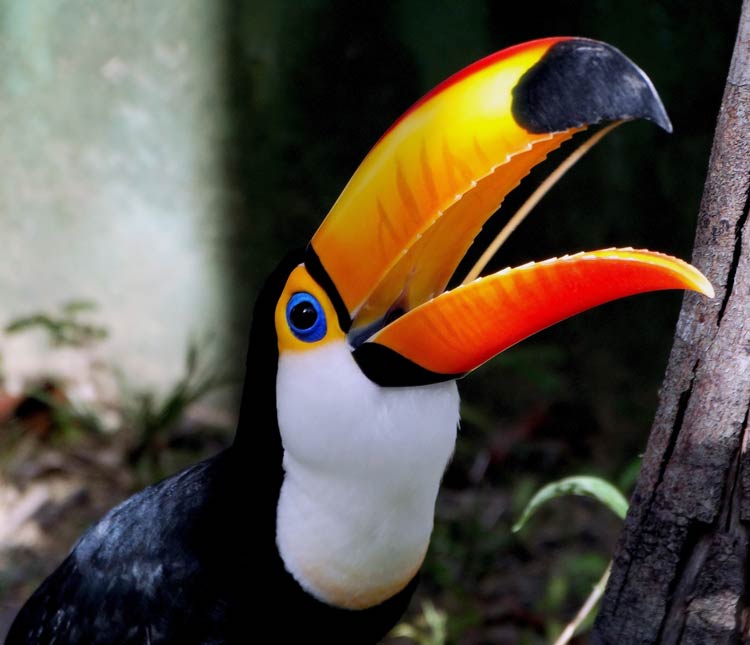
Q&A (questions and answers) about Toucans
Q: What is a toucan?
A: A toucan is a tropical bird known for its large, colorful bill.
Q: What do toucans eat?
A: Toucans eat a variety of foods, including fruit, insects, and small animals like lizards and bird eggs.
Q: Where do toucans live?
A: Toucans are found in Central and South America, primarily in tropical and subtropical forests.
Q: How big do toucans get?
A: Toucans range in size from the Lettered Aracari, which is around 33-35.5 cm long, to the Toco Toucan, which can reach up to 63 cm long and weigh up to 680 g.
Q: What is the purpose of a toucan’s bill?
A: While the toucan’s bill is often used for feeding, it also has other functions such as regulation of body temperature and as a visual and acoustic signal to communicate with other toucans.
Q: Are toucans endangered?
A: Some species of toucans are considered threatened due to habitat loss and other factors, but overall, the family of toucans is not considered endangered.
Q: How do toucans communicate?
A: Toucans communicate using a variety of vocalizations, including calls that can be heard up to half a mile away, as well as body language.
Q: Do toucans mate for life?
A: Toucans typically mate for the breeding season and may stay together for several seasons, but they do not mate for life.
Q: Can toucans be kept as pets?
A: Toucans can be kept as pets, but they require specialized care and a large amount of space to thrive. In some countries, it is illegal to keep toucans as pets.
Q: What is the lifespan of a toucan?
A: Toucans have a relatively long lifespan for birds, with some species living up to 20 years in the wild.
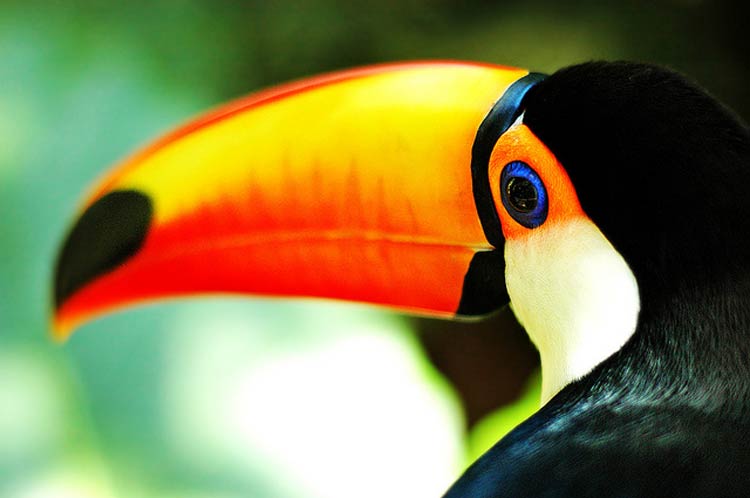
Recommended
- African lion
- Asian lion
- African elephant
- African forest elephant
- Asian elephant
- Moose
- Owls
- Parrots
- Giraffe
- Gorillas
- Zebroid
- Zebra
- Giant anteater
- Lizards

